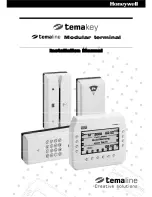
Section 150-319-254
Revision 02
Page 18
5.05
Figure 11 shows the PERFORMANCE
DATA screen for non-Doubler applications.
Both the Errored and Unavailable Seconds for both
HDSL loops and each G.703 input are listed at 15-
minute intervals over a four hour time interval.
Earlier and later data, in four-hour chunks on six
different screens, can be accessed by pressing P
(Previous) or N (Next) respectively. All of the
counters can be set to zero by pressing C (Clear)
from the ELU-319 SPAN STATUS Screen shown in
Figure 7. Note that since the ELU is considered the
master module, this clears
all performance data
screens at both the ELU-319 and the ERU-412. The
RS-232 terminal interface at the ERU-412 does not
allow the counters to be cleared.
5.06.
Figure 12 shows the 7-DAY
PERFORMANCE HISTORY Screen. The
“Errored Seconds” and “Unavailable Seconds” for
both HDSL loops and each of the two G.703 inputs
are listed for the current and previous seven days.
All of the counters can be set to zero by pressing C
(Clear) on the SPAN STATUS Screen (Figure 7).
Note that since the ELU is considered the master
module, this clears
all performance data screens at
both the ELU and the ERU. The RS-232 terminal
interface at the ERU-412 does not allow the
counters to be cleared.
5.07
Figure 13 shows the ALARM HISTORY
Screen for non-Doubler applications. The
alarms are defined in Section A Paragraph 4.02.
The “First” and “Last” columns contain the time and
date stA of the first and last occurrence of each
alarm. The “Current” column shows the status of
each alarm. The “Count” column lists the number of
times each alarm occurred. All the data can be
cleared by pressing C (Clear). The maximum non-
overflowing count is 999.
5.08
Selection “H” from the main menu allows the
Circuit ID # to be set. It is limited to 24
alpha- numeric characters. It, like the system
settings, is stored in NVRAM and thus remains
when power is lost. Note that the Circuit ID # is not
available at the ERU-412 Maintenance Port.
















































